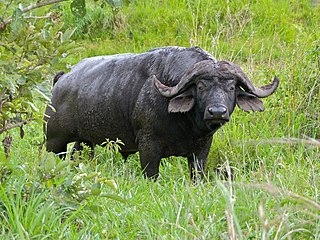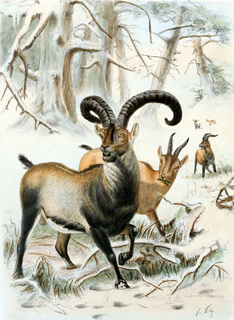
In biology, extinction is the termination of an organism or of a group of organisms (taxon), usually a species. The moment of extinction is generally considered to be the death of the last individual of the species, although the capacity to breed and recover may have been lost before this point. Because a species' potential range may be very large, determining this moment is difficult, and is usually done retrospectively. This difficulty leads to phenomena such as Lazarus taxa, where a species presumed extinct abruptly "reappears" after a period of apparent absence.

The biological subfamily Bovinae includes a diverse group of 10 genera of medium to large-sized ungulates, including domestic cattle, bison, African buffalo, the water buffalo, the yak, and the four-horned and spiral-horned antelopes. The evolutionary relationship between the members of the group is still debated, and their classification into loose tribes rather than formal subgroups reflects this uncertainty. General characteristics include cloven hooves and usually at least one of the sexes of a species having true horns. The largest extant bovine is the gaur.

A baronet or the rare female equivalent, a baronetess, is the holder of a baronetcy, a hereditary title awarded by the British Crown. The practice of awarding baronetcies was originally introduced in England in the 14th century and was used by James I of England in 1611 as a means of raising funds.

The IUCN Red List of Threatened Species, founded in 1965, has evolved to become the world's most comprehensive inventory of the global conservation status of biological species. It uses a set of criteria to evaluate the extinction risk of thousands of species and subspecies. These criteria are relevant to all species and all regions of the world, With its strong scientific base, the IUCN Red List is recognized as the most authoritative guide to the status of biological diversity. A series of Regional Red List are produced by countries or organizations, which assess the risk of extinction to species within a political management unit.

An extinct language is a language that no longer has any speakers, especially if the language has no living descendants. In contrast, a dead language is "one that is no longer the native language of any community", even if it is still in use, like Latin. Languages that currently have living native speakers are sometimes called modern languages to contrast them with dead languages, especially in educational contexts.
The following are lists of extinct animals:

The Pterygota are a subclass of insects that includes the winged insects. It also includes insect orders that are secondarily wingless.

The Tipulomorpha are an infraorder of Nematocera, containing the crane flies, a very large group, and allied families.

The Bibionomorpha are an infraorder of the suborder Nematocera. One of its constituent families, the Anisopodidae, is the presumed sister taxon to the entire suborder Brachycera. Several of the remaining families in the infraorder are former subfamilies of the Mycetophilidae, which has been recently subdivided. The family Axymyiidae has recently been removed from the Bibionomorpha to its own infraorder Axymyiomorpha.

The conservation status of a group of organisms indicates whether the group still exists and how likely the group is to become extinct in the near future. Many factors are taken into account when assessing conservation status: not simply the number of individuals remaining, but the overall increase or decrease in the population over time, breeding success rates, and known threats. Various systems of conservation status exist and are in use at international, multi-country, national and local levels as well as for consumer use.
Neontology is a part of biology that, in contrast to paleontology, deals with living organisms. It is the study of extant taxa : taxa with members still alive, as opposed to (all) being extinct. For example:

A critically endangered (CR) species is one that has been categorized by the International Union for Conservation of Nature (IUCN) as facing an extremely high risk of extinction in the wild.

A species that is extinct in the wild (EW) is one that has been categorized by the International Union for Conservation of Nature as known only by living members kept in captivity or as a naturalized population outside its historic range due to massive habitat loss.

An extinct comet is a comet that has expelled most of its volatile ice and has little left to form a tail and coma. In a dormant comet, rather than being depleted, any remaining volatile components have been sealed beneath an inactive surface layer.
Helminthochiton is an extinct genus of polyplacophoran mollusc. Helminthochiton became extinct during the Permian period.
Phthipodochiton is an extinct genus of molluscs, known from several fossils from the upper Ordovician fauna of the Lady Burn Starfish beds of Girvan, Scotland. It shows a mixture of aplacophoran body plan and polyplacophoran-like valves, and it is an informative fossil in the evolution of aculiferan mollusks.

De-extinction, or resurrection biology, or species revivalism is the process of creating an organism, which is either a member of, or resembles an extinct species, or breeding population of such organisms. Cloning is the most widely proposed method, although selective breeding has also been proposed. Similar techniques have been applied to endangered species.










